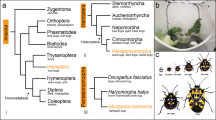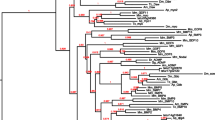Abstract
In fruit flies, the gene fruitless (fru) governs the establishment of the potential for male sexual behavior. We partially cloned fru from a hemimetabolous insect for the first time and we compared fru among three closely related and acoustically communicating grasshopper species: Chorthippus biguttulus, C. brunneus, and C. mollis. The fru of grasshoppers is organized similarly to fru of holometabolous insects, with a BTB and Zn-finger domains separated by a nonconserved repetitive linker. As in Drosophila, several transcripts of fru are found in grasshoppers. We also present evidence for the coexistence of several copies of fru in the grasshopper genome. Within species these copies are almost identical and carry almost-fixed species-specific differences. This suggests that the paralogous copies of fru in grasshoppers do not evolve independently from each other.




Similar content being viewed by others
References
Altschul SF, Madden TL, Schäffer AA, Zhang J, Zhang Z, Miller W, Lipman DJ (1997) Gapped BLAST and PSI-BLAST: a new generation of protein database search programs. Nucleic Acids Res 25:3389–3402
Anand A, Villella A, Ryner LC, Carlo T, Goodwin SF, Song HJ, Gailey DA, Morales A, Hall JC, Baker BS, Taylor BJ (2001) Molecular genetic dissection of the sex-specific and vital functions of the Drosophila melanogaster sex determination gene fruitless. Genetics 158:1569–1595
Baker BS, Taylor BJ, Hall JC (2001) Are complex bahaviors specified by dedicated regulatory genes? Reasoning from Drosophila. Cell 105:13–24
Bensasson D, Petrov DA, Zhang DX, Hartl DL, Hewitt GM (2001) Genomic gigantism: DNA loss is slow in mountain grasshoppers. Mol Biol Evol 8:246–253
Billeter JC, Goodwin SF (2004) Characterization of Drosophila fruitless-gal4 transgenes reveals expression in male-specific fruitless neurons and innervation of male reproductive structures. J Comp Neurol 475:270–287
Brown DD, Wensink PC, Jordan E (1972) Xenopus laevis and Xenopus mulleri: the evolution of tandem genes. J Mol Biol 63:57–73
Cooper SJ, Hewitt GM (1993) Nuclear DNA sequence divergence between parapatric subspecies of the grasshopper Chorthippus parallelus. Insect Mol Biol 2:185–194
Dauwalder B, Tsujimoto S, Moss J, Mattox W (2002) The Drosophila takeout gene is regulated by the somatic sex-determination pathway and affects male courtship behavior. Genes Dev 16:2879–2892
Davis T, Kurihara J, Yamamoto D (2000a) Genomic organisation and characterisation of the neural sex-determination gene fruitless (fru) in the Hawaiian species Drosophila heteroneura. Gene 246:143–149
Davis T, Kurihara J, Yoshino E, Yamamoto D (2000b) Genomic organisation of the neural sex determination gene fruitless (fru) in the Hawaiian species Drosophila silvestris and the conservation of the fru BTB protein-protein-binding domain throughout evolution. Hereditas 132:67–78
Demir E, Dickson BJ (2005) fruitless splicing specifies male courtship behavior in Drosophila. Cell 121:785–794
Drapeau MD, Radovic A, Wittkopp PJ, Long AD (2003) A gene necessary for normal male courtship, yellow, acts downstream of fruitless in the Drosophila melanogaster larval brain. J Neurobiol 55:53–72
Gailey DA, Ohshima S, Santiago SJ, Montez JM, Arellano AR, Robillo J, Villarimo CA, Roberts L, Fine E, Villella A, Hall JC (1997) The muscle of lawrence in Drosophila: a case of repeated evolutionary loss. Proc Natl Acad Sci USA 94:4543–4547
Gailey DA, Ho SK, Ohshima S, Liu JH, Eyassu M, Washington MA, Yamamoto D, Davis T (2000) A phylogeny of the Drosophilidae using the sex-behaviour gene fruitless. Hereditas 133:81–83
Gailey DA, Billeter JC, Liu JH, Bauzon F, Allendorfer JB, Goodwin SF (2006) Functional conservation of the fruitless male sex determination gene across 250 million years of insect evolution. Mol Biol Evol 23(3):633–643
Goodwin SF, Taylor BJ, Villella A, Foss M, Ryner LC, Baker BS, Hall JC (2000) Aberrant splicing and altered spatial expression patterns in fruitless mutants of Drosophila melanogaster. Genetics 154:725–745
Greenspan RJ, Ferveur JF (2000) Courtship in Drosophila. Annu Rev Genet 34:205–232
Heinrichs V, Ryner LC, Baker BS (1998) Regulation of sex-specific selection of fruitless 5’ splice sites by transformer and transformer-2. Mol Cell Biol 18:450–458
Helversen Ov, Helversen Dv (1994) Forces driving coevolution of song and song recognition in grasshoppers. In: Schildberger K, Elsner N (eds) Neural basis of behavioural adaptations. Gustav Fischer Verlag, Stuttgart, pp 253–284
Innan H (2004) Theories for analyzing polymorphism data in duplicated genes. Genes Genet Syst 79:65–75
Ito H, Fujitani K, Usui K, Shimizu-Nishikawa K, Tanaka S, Yamamoto D (1996) Sexual orientation in Drosophila is altered by the satori mutation in the sex-determination gene fruitless that encodes a zinc finger protein with a BTB domain. Proc Natl Acad Sci USA 93:9687–9692
Jacobs W (1953) Verhaltensbiologische Studien an Feldheuschrecken. Z Tierpsychol Beiheft 1:1–228
Kumar S, Tamura K, Nei M (2004) MEGA3: Integrated software for Molecular Evolutionary Genetics Analysis and sequence alignment. Brief Bioinform 5:150–163
Kyriacou CP (2002) Single gene mutations in Drosophila: What can they tell us about the evolution of sexual behaviour? Genetica 116:197–203
Lawrence PA, Johnston P (1986) The muscle pattern of a segment of Drosophila may be determined by neurons and not by contributing myoblasts. Cell 45:505–513
Lee G, Hall JC (2000) A newly uncovered phenotype associated with the fruitless gene of Drosophila melanogaster: aggression-like head interactions between mutant males. Behav Genet 30:263–275
Lee G, Foss M, Goodwin SF, Carlo T, Taylor BJ, Hall JC (2000) Spatial, temporal, and sexually dimorphic expression patterns of the fruitless gene in the Drosophila central nervous system. J Neurobiol 43:404–426
Lynch M, Conery JS (2000) The evolutionary fate and consequences of duplicate genes. Science 290:1151–1155
Manoli DS, Foss M, Villella A, Taylor BJ, Hall JC, Baker BS (2005) Male-specific fruitless specifies the neural substrates of Drosophila courtship behaviour. Nature 436:395–400
Marchler-Bauer A, Anderson JB, Cherukuri PF, DeWeese-Scott C, Geer LY, Gwadz M, He S, Hurwitz DI, Jackson JD, Ke Z, Lanczycki CJ, Liebert CA, Liu C, Lu F, Marchler GH, Mullokandov M, Shoemaker BA, Simonyan V, Song JS, Thiessen PA, Yamashita RA, Yin JJ, Zhang D, Bryant SH (2005) CDD: a Conserved Domain Database for protein classification. Nucleic Acids Res 33:D192–D196
Mason DJ, Butlin RK, Gacesa P (1995) An unusual mitochondrial DNA polymorphism in the Chorthippus biguttulus species group (Orthoptera: Acrididae). Mol Ecol 4:121–126
Mount SM, Burks C, Hertz G, Stormo GD, White O, Fields C (1992) Splicing signals in Drosophila: intron size, information content, and consensus sequences. Nucleic Acids Res 20:4255–4262
Nei M, Rooney AP (2005) Concerted and birth-and-death evolution of multigene families. Annu Rev Genet 39:121–152
Nei M, Rogozin IB, Piontkivska H (2000) Purifying selection and birth-and-death evolution in the ubiquitin gene family. Proc Natl Acad Sci USA 97:10866–10871
Parkin EJ, Butlin RK (2004) Within- and between-individual sequence variation among ITS1 copies in the meadow grasshopper Chorthippus parallelus indicates frequent intrachromosomal gene conversion. Mol Biol Evol 21:1595–1601
Petrov DA, Sangster TA, Johnston JS, Hartl DL, Shaw KL (2000) Evidence for DNA loss as a determinant of genome size. Science 287:1060–1062
Piontkivska H, Nei M (2003) Birth-and-death evolution in primate MHC class I genes: divergence time estimates. Mol Biol Evol 20:601–609
Piontkivska H, Rooney AP, Nei M (2002) Purifying selection and birth-and-death evolution in the histone H4 gene family. Mol Biol Evol 19:689–697
Ragge DR (1987) Speciation and biogeography of some southern european Orthoptera, as revealed by their songs. In: Baccetti B (ed) Evolutionary biology of orthopteroid insects. Ellis Horwood, Chichester, UK, pp 418–426
Rooney AP (2004) Mechanisms underlying the evolution and maintenance of functionally heterogeneous 18S rRNA genes in Apicomplexans. Mol Biol Evol 21:1704–1711
Rooney AP, Ward TJ (2005) Evolution of a large ribosomal RNA multigene family in filamentous fungi: birth and death of a concerted evolution paradigm. Proc Natl Acad Sci USA 102:5084–5089
Rooney AP, Piontkivska H, Nei M (2002). Molecular evolution of the nontandemly repeated genes of the histone 3 multigene family. Mol Biol Evol 19:68–75
Ryner LC, Goodwin SF, Castrillon DH, Anand A, Villella A, Baker BS, Hall JC, Taylor BJ, Wasserman SA (1996) Control of male sexual behavior and sexual orientation in Drosophila by the fruitless gene. Cell 87:1079–1089
Song HJ, Taylor BJ (2003) fruitless gene is required to maintain neuronal identity in evenskipped-expressing neurons in the embryonic CNS of Drosophila. J Neurobiol 55:115–133
Song HJ, Billeter JC, Reynaud E, Carlo T, Spana EP, Perrimon N, Goodwin SF, Baker BS, Taylor BJ (2002) The fruitless gene is required for the proper formation of axonal tracts in the embryonic central nervous system of Drosophila. Genetics 162:1703–1724
Swofford DL (2000) PAUP*: Phylogenetic Analysis Using Parsimony (*and other methods). Sinauer, Sunderland: MA
Usui-Aoki K, Ito H, Ui-Tei K, Takahashi K, Lukacsovich T, Awano W, Nakata H, Piao ZF, Nilsson EE, Tomida J, Yamamoto D (2000) Formation of the male-specific muscle in female Drosophila by ectopic fruitless expression. Nat Cell Biol 2:500–506
Villella A, Gailey DA, Berwald B, Ohshima S, Barnes PT, Hall JC (1997) Extended reproductive roles of the fruitless gene in Drosophila melanogaster revealed by behavioral analysis of new fru mutants. Genetics 147:1107–1130
Yamamoto D, Nakano Y (1999) Sexual behavior mutants revisited: molecular and cellular basis of Drosophila mating. Cell Mol Life Sci 56:634–646
Yamamoto D, Usui-Aoki K, Shima S (2004) Male-specific expression of the fruitless protein is not common to all Drosophila species. Genetica 120:267–272
Zhang J, Dyer KD, Rosenberg HF (2000) Evolution of the rodent eosinophil-associated RNase gene family by rapid gene sorting and positive selection. Proc Natl Acad Sci USA 97:4701–4706
Zimmer EA, Martin SL, Beverley SM, Kan YW, Wilson AC (1980) Rapid duplication and loss of genes coding for the chains of hemoglobin. Proc Natl Acad Sci USA 77:2158–2162
Zollman S, Godt D, Privé GG, Couderc JL, Laski FA (1994) The BTB domain, found primarily in zinc finger proteins, defines an evolutionarily conserved family that includes several developmentally regulated genes in Drosophila. Proc Natl Acad Sci USA 91:10717–10721
Acknowledgments
We thank Andrea Ross for her assistance in the laboratory. We are grateful to Marc Holderied for a critical reading of the manuscript and helpful advice. We also thank two anonymous reviewers for valuable comments that significantly improved the manuscript. This work was supported by a HWP grant to J. U. and by the Deutsche Forschungsgemeinschaft (DFG) grant within the priority program “Radiations–Origins of Biological Diversity” to F.M.
Author information
Authors and Affiliations
Corresponding author
Additional information
[Reviewing Editor: Dr. Willie Swanson]
Rights and permissions
About this article
Cite this article
Ustinova, J., Mayer, F. Alternative Starts of Transcription, Several Paralogues, and Almost-Fixed Interspecific Differences of the Gene fruitless in a Hemimetabolous Insect. J Mol Evol 63, 788–800 (2006). https://doi.org/10.1007/s00239-005-6230-2
Received:
Accepted:
Published:
Issue Date:
DOI: https://doi.org/10.1007/s00239-005-6230-2




